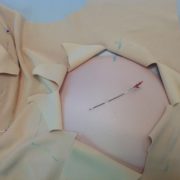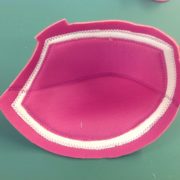Seams in your Bra Cup
Unless you have access to seamless pre-formed foam cups – it is very likely that you will use seams in your bra cup to make the fabric fit over the breast. Don’t be disappointed! The very best European bras, such as Lejaby, and La Perla use seaming, and they never apologise for it. In our school, we have even referred to any seamed bra as having “fine European styling”, but the correct name for it is a cut-and-sew cup. Here are some reasons why you should consider seams in your bra cup.
Seam Orientations
A diagonal seam has its upper end starting somewhere in the armhole curve, anywhere between the strap attachment point and the wire line. Like horizontal seaming, it can be tilted higher or lower within its limited space, depending on the look that is desired. I happen to like the look of a high diagonal seam, as I think it is a more flattering seamline for the wearer. It can also be paired with a split lower cup, although the split is often tilted more toward the side seam, so as to form more of a “T” seam at the cross cup. Compare it to the drawing of the split lower cup on the horizontal cup
The vertical seamline starts anywhere along the top edge of the bra, between the strap attachment point and the wire line near the centre front (often called the neckline edge). A vertical seam starts anywhere along this edge. It may start close to the strap but I have seen it in the middle of the neckline (especially on pre-formed foam cups covered with lace). Having a vertical seam allows the use of lace on the part of the cup closest to the centre front (called the inner cup). This is a totally different look than lace on the upper cup, which would normally be the case in a diagonal or horizontal cup. The seam that runs vertically under the bust gives more support than would normally be present with fabric alone; the stitches can keep the fabric seam from stretching. Vertical seams are also present in cups with a curved seam from the strap. If you look closely, you can see that the seam that runs through the bust point (if carried to the edge) is actually making the bra on the right a vertical seamed cup. It is always the seam that crosses the bust point that determines the name of the seam.








Leave a Reply
Want to join the discussion?Feel free to contribute!